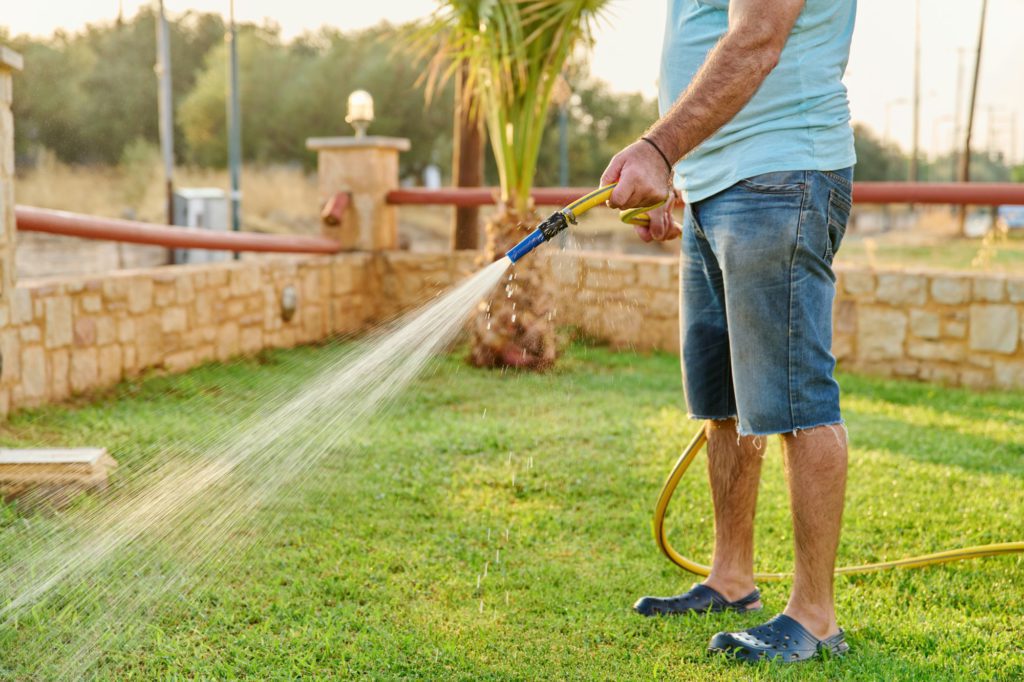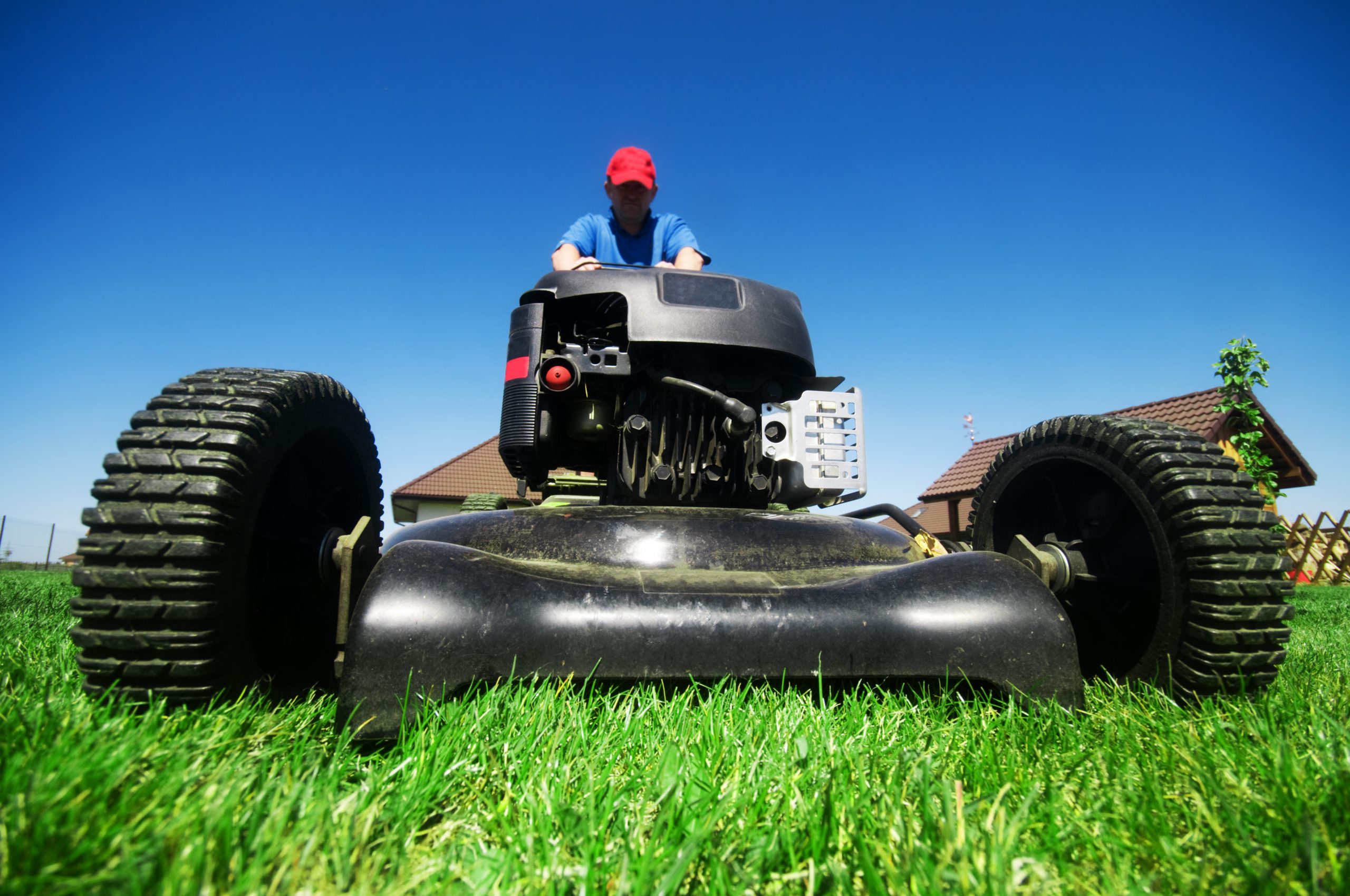To keep your lawn lush during summer, it’s essential to water it properly. Aim for 1 to 1.5 inches of water each week, delivered over two to three sessions lasting 25-30 minutes. Watering in the early morning helps minimize evaporation and reduces the risk of fungal diseases. This routine supports deep root growth and guarantees your lawn stays healthy. But how do you tailor this advice to your specific climate and soil conditions?
How Many Minutes to Water Your Lawn in Summer?
To keep your lawn lush and healthy during summer, aim to water it 1 to 1.5 inches per week, which generally means two to three watering sessions.
Each session should last about 25-30 minutes, ensuring your lawn gets roughly ½ inch of water.
This approach helps maintain deep root growth and reduces the risk of runoff, keeping your grass vibrant and well-nourished.
The Golden Rule: 1 to 1.5 Inches Per Week
Achieving the right balance of water for your lawn during the summer is essential for maintaining its health and vibrancy.
Lawns need about 1 to 1.5 inches of water per week for proper watering. This typically means watering every 2 to 3 days, delivering around ½ inch each time.
Use the “tuna can method” to measure how long to run your sprinkler, ensuring effective hydration.
Why Two to Three Sessions Work Best
When it comes to watering your lawn in summer, breaking it into two or three sessions per week works best for several reasons.
A consistent watering schedule guarantees deep watering, promoting healthier grass by encouraging deeper root growth. Each session, lasting about 20-30 minutes, allows the soil to absorb water efficiently, preventing runoff.
Watering early in the morning maximizes absorption, minimizing evaporation.
Why Morning Matters: Best Time of Day to Water

Watering your lawn in the early morning is essential for maintaining its health and vibrance during the summer months.
By watering between 6:00 AM and 10:00 AM, you minimize evaporation and allow moisture to effectively reach the grass roots. This timing helps the grass dry by evening, reducing the risk of fungal diseases.
Morning watering also utilizes cooler temperatures and lower wind speeds for ideal hydration.
How to Tailor Your Lawn Watering Routine
To effectively tailor your lawn watering routine, consider the type of soil you have, as sandy soils drain quickly and may require more frequent watering, while clay soils retain moisture longer.
Moreover, the type of grass and its root depth play an essential role; deeper roots often need less frequent watering but in larger amounts.
Keep an eye on the weather conditions and rainfall, as they can affect how much supplemental watering your lawn requires, ensuring you adjust your schedule accordingly to maintain a healthy and vibrant lawn.
Easily hire the best lawn & landscape pros working in your neighborhood.
Soil Type & Water Retention
Understanding how soil type affects water retention is essential for tailoring your lawn watering routine effectively.
Sandy soil drains quickly, so you’ll need to water more frequently, about every 2-3 days.
Clay soil holds water longer, requiring longer watering sessions.
Loamy soil balances these needs, requiring about twice-weekly watering for 20-30 minutes.
Use a screwdriver test to check moisture depth, adjusting as needed.
Grass Type & Root Depth
Different soil types influence how you water your lawn, but it’s equally important to take into account the grass type and root depth.
Warm-season grasses like Bermuda need ½ inch every 2-3 days, promoting strong root systems.
Cool-season grasses, such as Fescue, require 1 inch weekly over three sessions to reach a 4-inch root depth.
Tailor watering to grass type for ideal lawn health.
Weather Conditions & Rainfall
When tailoring your lawn watering routine to weather conditions and rainfall, it’s crucial to take into account both the frequency and amount of water your grass receives.
Monitor local weather forecasts to adjust for rain, ensuring you don’t overwater. Here’s how:
- Track Rainfall: Count precipitation towards the weekly 1-inch water goal.
- Adapt to Heat: Increase watering in temperatures above 85°F.
- Consider Soil: Sandy soils need more frequent watering.
Texas and California Summers
In the intense heat of a Texas summer, you’ll need to water your lawn about ½ inch every two days to keep it healthy and green, especially when temperatures soar above 95°F.
For California, aim to provide around 1 inch of water per week, adjusting for more frequent watering if dry spells hit.
In both states, it’s best to water early in the morning between 6:00 AM and 10:00 AM to reduce evaporation and guarantee the water reaches the roots effectively.
Easily hire the best lawn & landscape pros working in your neighborhood.
How Long to Water Lawn in Texas Summer
Ever wonder how much water your Texas lawn needs during those scorching summer days?
To maintain a healthy summer lawn, water your lawn about ½ inch every 2 days when temperatures exceed 95°F.
Here’s how you can manage it:
- Water Duration: Use a sprinkler for 20-30 minutes.
- Screwdriver Test: Confirm it penetrates 3 inches in clay soil.
- Tuna Can Method: Measure ½ inch per session.
How Long to Water Lawn in California Summer
Caring for a lawn in the summer heat requires a strategic approach to watering.
In California’s summer, water your lawn with about ½ inch every 2-3 days. This translates to summer watering sessions of 20-30 minutes, depending on your sprinkler’s efficiency.
Use the “tuna can method” to measure accurately.
Water early, ideally between 6 AM and 10 AM, to reduce evaporation and optimize absorption.
How to Tell If Your Lawn Is Overwatered or Thirsty

To determine if your lawn is overwatered or thirsty, start by observing the grass and soil conditions closely.
Look for signs of overwatering, such as yellowing grass, fungal growth, and muddy soil, which indicate poor oxygen levels.
If your lawn shows dry patches, footprints that linger, and grass that doesn’t spring back, it may be thirsty and in need of water.
Signs of Overwatering
A lush, green lawn is a common goal for many homeowners, but overwatering can quickly turn this dream into a nightmare.
Recognizing overwatered lawns is essential. Look for these signs that the grass is suffering:
- Soggy Soil: Waterlogged soil with standing water.
- Yellow Grass: Wilting despite moisture.
- Excessive Weeds: Nutsedge and crabgrass thrive in overly wet conditions.
Signs of Underwatering
When your lawn doesn’t receive enough water, certain telltale signs can indicate it’s time to adjust your watering routine.
Look for dry patches with straw-colored grass, visible footprints that linger, and wilting grass. These clues suggest dehydration.
Test soil moisture by inserting a screwdriver; if it doesn’t penetrate 3 inches, it’s too dry.
Regular monitoring helps guarantee your grass stays healthy.
Need More Than Watering Help? LawnGuru Has You Covered
Although watering your lawn correctly during the summer is essential, LawnGuru offers much more to guarantee your grass stays lush and healthy.
We provide tailored lawn watering schedules and techniques for peak watering time. Plus, we deliver personalized lawn care plans.





